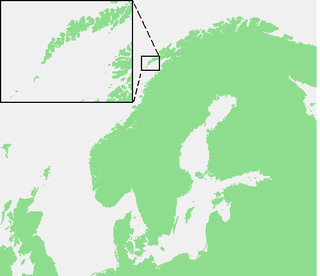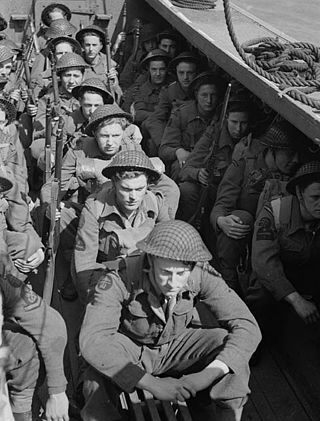Related Research Articles

The Commandos, also known as the British Commandos, were formed during the Second World War in June 1940, following a request from Winston Churchill, for special forces that could carry out raids against German-occupied Europe. Initially drawn from within the British Army from soldiers who volunteered for the Special Service Brigade, the Commandos' ranks would eventually be filled by members of all branches of the British Armed Forces and a number of foreign volunteers from German-occupied countries. By the end of the war 25,000 men had passed through the Commando course at Achnacarry. This total includes not only the British volunteers, but volunteers from Greece, France, Belgium, Netherlands, Canada, Norway, Poland, and the United States Army Rangers and US Marine Corps Raiders, Portuguese Fuzileiros Portuguese Marine Corps were modelled on the Commandos.
Layforce was an ad hoc military formation of the British Army consisting of a number of commando units during the Second World War. Formed in February 1941 under the command of Colonel Robert Laycock, after whom the force was named, it consisted of approximately 2,000 men and served in the Middle Eastern theatre of operations. Initially tasked with conducting raiding operations to disrupt Axis lines of communication in the Mediterranean it was planned that they would take part in operations to capture the Greek island of Rhodes.

No. 3 Commando was a battalion-sized Commando unit raised by the British Army during the Second World War. Formed in July 1940 from volunteers for special service, it was the first such unit to carry the title of "Commando". Shortly afterwards the unit was involved in a largely unsuccessful raid upon the German-occupied Channel Island of Guernsey.

No. 62 Commando or the Small Scale Raiding Force (SSRF) was a British Commando unit of the British Army during the Second World War. The unit was formed around a small group of commandos under the command of the Special Operations Executive (SOE). They carried out a number of raids before being disbanded in 1943.

Operation Claymore was a British/Norwegian commando raid on the Lofoten Islands of northern Norway during the Second World War. The Lofoten Islands were an important centre for the production of fish oil and glycerine, used in the German war economy. The landings were carried out on 4 March 1941, by 500 men of No. 3 Commando, No. 4 Commando, and a Royal Engineers section, and 52 men from Norwegian Independent Company 1. Supported by the 6th Destroyer Flotilla and two troop transports of the Royal Navy, the force landed almost unopposed. The original plan was to avoid contact with German forces and inflict the maximum of damage to German-controlled industry. They achieved their objective of destroying fish oil factories and some 3,600 t of oil and glycerine. The force returned with some 228 German prisoners, 314 Norwegian recruits, and a number of Quisling regime collaborators.

Operation Anklet was the codename given to a British Commando raid during the Second World War. The raid on the Lofoten Islands was carried out in December 1941, by 300 men from No. 12 Commando and the Norwegian Independent Company 1. The landing party was supported by 22 ships from three navies.
Brigadier John Frederick Durnford-Slater, DSO and bar was a British Army officer who was credited with establishing the first Army commando unit during the Second World War.
No. 8 (Guards) Commando was a unit of the British Commandos and part of the British Army during the Second World War. The Commando was formed in June 1940 primarily from members of the Brigade of Guards. It was one of the units selected to be sent to the Middle East as part of Layforce. On arrival they became known as 'B' Battalion in an attempt at deception, not wanting the Axis forces to know there was a commando formation in the theatre of war. The commando participated in the Battle of Crete and around Tobruk before being disbanded in late 1941. After this, many of its personnel went on to serve in other commando units formed in the area, including the Special Air Service.
No. 7 Commando was a unit of the British Commandos and part of the British Army during the Second World War. The commando was formed in August 1940 in the United Kingdom. No. 7 Commando was transferred to the Middle East as part of Layforce. Committed to the Battle of Crete, it suffered heavy casualties, after which it was disbanded.
No. 11 (Scottish) Commando was a battalion-sized commando unit of the British Army during the Second World War. Formed in Scotland, members of No. 11 (Scottish) Commando adopted the Tam o'shanter as their official headdress.

No. 12 Commando was a battalion-sized commando unit of the British Army during the Second World War. Formed in 1940 in Northern Ireland, they carried out a number of small-scale raids in Norway and France between 1941 and 1943 before being disbanded and its personnel dispersed to other commando units.
No. 5 Commando was a battalion-sized commando unit of the British Army during the Second World War.

No. 9 Commando was a battalion-sized British Commando unit raised by the British Army during the Second World War. It took part in raids across the English Channel and in the Mediterranean, ending the war in Italy as part of the 2nd Special Service Brigade. Like all Army commando units it was disbanded in 1946.

No. 6 Commando was a battalion-sized British Army commando unit of the Second World War. Although it was raised to conduct small-scale raids and harass garrisons along the coast of German-occupied France, it was mainly employed as a highly trained infantry assault unit.

The Commandos formed during the Second World War, following an order from the British Prime Minister Winston Churchill in June 1940 for a force that could carry out raids against German-occupied Europe. Churchill stated in a minute to General Ismay on 6 June 1940: "Enterprises must be prepared, with specially-trained troops of the hunter class, who can develop a reign of terror down these coasts, first of all on the "butcher and bolt" policy..." Commandos were all volunteers for special service and originally came from the British Army but volunteers would eventually come from all branches of the United Kingdom's armed forces and foreign volunteers from countries occupied by the Germans. These volunteers formed over 30 individual units and four assault brigades.
No. 14 (Arctic) Commando sometimes also called the Special Commando Boating Group, was a 60-man Commando unit of the British Army during the Second World War. The commando was formed in 1942 for service in the Arctic and was disbanded in 1943.

Operation Myrmidon was the planned raid during the Second World War by No. 1 Commando and No. 6 Commando in April 1942. This operation was an abortive raid on the Adour Estuary in south-western France. The plan was to disrupt road and rail transport between France and Spain by landing approximately 3,000 troops, consisting of two commandos, No. 1 and No. 6, who would be followed up by one and a half Royal Marine battalions along with an armoured regiment and a motor battalion. After embarking on the transport ships Queen Emma and Princess Beatrix, the force spent a month sailing off the French coast disguised as Spanish merchant ships. On 5 April the ships approached the mouth of the estuary in order to carry out the landing. However, amid bad weather, they encountered a sandbar that they had not expected and were unable to pass it; the raid was called off and the ships returned to the United Kingdom.

The Raid onBardia was an amphibious landing at the coastal town of Bardia in North Africa by British Commandos over the night of 19/20 April 1941 during the Second World War. The raid was carried out by No. 7 Commando, also known as A Battalion Layforce, together with a small detachment from the Royal Tank Regiment; the raiders were supported by five navy ships and a submarine. The raid destroyed an Italian artillery battery and a supply dump. It was deemed a success despite the loss of 71 men. The more lasting strategic effect of the raid was the diversion of a German armoured brigade from the front line to provide rear area security.
The Twin Pimples Raid was a British Commando raid on a feature in the Italian lines during the siege of Tobruk in the Second World War. The raid, carried out by men of the No. 8 (Guards) Commando and the Royal Australian Engineers, was a complete success. However it did not end the siege; that continued until November 1941, when the Allied advance during Operation Crusader reached the town.
References
- Chappell, Mike (1996). Army Commandos 1940–1945. Elite Series (No. 64). London: Osprey. ISBN 1-85532-579-9.
- Saunders, Hilary St. George (1959) [1949]. The Green Beret: The Commandos at War. Four Square Books (No. 153). London: Landsborough. OCLC 1056141355.